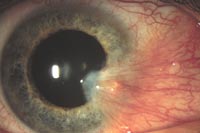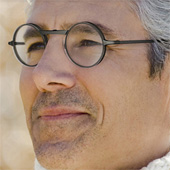August 31st, 2011 by Dr. Val Jones in Audio, Expert Interviews
1 Comment »

Dori Carlson, O.D.
In a recent interview with the president of the American Optometric Association (AOA), Dr. Dori Carlson, I learned the surprising statistic that about 1 in 4 school age children have an undetected or undiagnosed vision problem. School vision screenings, while helpful, still miss more than 75% of these problems. And for those kids who are discovered to have a vision problem during a school screening, upwards of 40% receive no follow up after the diagnosis. Clearly, we need to do better at diagnosing and treating childhood visual deficits. My full conversation with Dr. Carlson can be listened to below:
Dr. Carlson told me that the solution involves Read more »
July 11th, 2011 by admin in News
No Comments »

 Researchers at MIT have developed a cheap and easy to use system, called Catra, that uses a cameraphone clip-on device to map out cataracts.
Researchers at MIT have developed a cheap and easy to use system, called Catra, that uses a cameraphone clip-on device to map out cataracts.
The technology functions by sweeping the eye with a beam of light and using the phone’s camera to detect fuzzy spots. It can provide both a map of the cataracts and maybe help make an overall assessment of whether surgery might be necessary.
From MIT News:
While the standard test for cataracts in an ophthalmologist’s office assigns a score on a scale of 1 to 4 — from no cataracts to completely blocked vision — the new, inexpensive test actually provides much more information. Media Lab graduate student Vitor Pamplona, a member of the team developing Catra, explains that it “scans the lens of the eye and creates a map showing position, size, shape and density of cataracts.” Read more »
*This blog post was originally published at Medgadget*
July 4th, 2011 by KerriSparling in True Stories
1 Comment »

 Back at the beginning of May, the Bird took a swipe at my left eyeball with her little birdie talon, ripping off a nice, solid chunk of my cornea and leaving me in some serious pain. It was a rough couple of days, especially because Chris was away for the week on business, but my family and friends pitched in to help with the baby and to allow me to heal.
Back at the beginning of May, the Bird took a swipe at my left eyeball with her little birdie talon, ripping off a nice, solid chunk of my cornea and leaving me in some serious pain. It was a rough couple of days, especially because Chris was away for the week on business, but my family and friends pitched in to help with the baby and to allow me to heal.
I figured I was done with this issue.
“You may want to be careful about recurrence, Kerri. With this kind of injury, it does happen.” My eye doctor warned me, handing me a small tube of eye goop stuff. “This is Muro 128. Pull down your lower eyelid and smear this in there. It will help keep your eye coated while you sleep.”
(Oh eyeball injuries. You make me feel old, because if you Google “Muro 128,” you’ll see that this product is targeted at the 60+ crowd. Throw in a few tennis balls for my walker and I’m ready for my debut at the bingo hall.)
I used the stuff, but it wasn’t enough Read more »
*This blog post was originally published at Six Until Me.*
July 1st, 2011 by Dr. Val Jones in Audio, Health Tips
No Comments »

A Pterygium
Dermatologists have done a great job promoting sun safety. We all know that we should use sunscreen or sunblock to avoid burns, and to reapply it religiously when we plan to be outdoors for long periods of time. But how often do we think about protecting our eyes from the same UV rays?
A dear friend of mine has been on a long-term medicine that makes her skin especially sun-sensitive. She did not take sufficient precautions to protect her eyes from UV radiation (though she always wore sunscreen on her skin), and she developed a pterygium that looks just like the photograph above. Her condition reminded me of the importance of eye protection, and I thought I’d offer you 5 excellent reasons to start shielding your eyes from the sun. UV protection is critical for avoiding:
1. Photokeratitis. Photokeratitis is essentially a sunburn of the front layer (cornea) of your eyeball. If you’ve ever had a burning sensation in your eyes after a long day at the beach, or in the snow, you may have burned your eyes. Just as skin sunburns are painful and take a few days to calm down, eye pain can be very uncomfortable. But worse than the temporary discomfort is the increased long-term risks of pterygia, cataracts, and other eye conditions (see below).
2. Pterygia. Pterygia are overgrowths of corneal tissue that can grow across the iris and pupil. They can be cosmetically unsightly, and can block vision if they grow large. They are caused almost exclusively by UV damage, and are most common in people who live near the equator (because their exposure to UV radiation is highest). Surgery is the only known treatment for pterygia, though as many as 50% grow back, and surgical divets in the cornea can cause visual problems.
3. Cataracts. Cataracts are opacities of the eye lenses that lead to partial or total blindness. The exact mechanism by which they occur is unclear, though we know that sun exposure contributes to their development. Cataracts are the number one cause of blindness in the world.
4. Skin Cancers. Basal cell carcinoma (BCC) is a type of skin cancer that primarily develops on skin that has been sunburned, especially in childhood. Melanoma is a deadly form of skin cancer that is much rarer than BCC, but also most commonly develops on skin that has been burned. Squamous cell carcinoma (SCC) is the least invasive type of skin cancer, and usually develops on skin that has had the largest total amount of sun exposure over a lifetime. People who don’t protect the thin eye skin and lids from UV radiation (beginning in childhood) are more likely to develop cancer around the eyes
5. Macular Degeneration. Exposure to the sun’s UV rays can cause damage to the deep structures of the eye, including the retina. Light focused on the macula (the most important part of the retina for vision) can cause damage in the area over time. Macular degeneration results in visual damage and even blindness.
Ok, so I hope I’ve convinced you that UV protection is critically important for your eyes… How can you protect yourself? There are 4 primary strategies:
1. Wear UV protective sunglasses. When buying sunglasses, check out their product labels and avoid glasses that are purely cosmetic – opt for those that block 99-100% of UV A and B rays. Larger glasses and wrap-arounds offer the most coverage. Remember that kids need sunglasses too!
2. Wear a wide-brimmed hat. Although a hat doesn’t always protect you from glare and light reflection from other surfaces, it can reduce the total amount of radiation that reaches your eyes and skin.
3. Wear UV-protective contact lenses. Most people don’t realize that some contact lenses are manufactured with a UV protective layer already built in. Although they are not large enough to protect the entire eye surface (or the skin around the eye) they offer an added layer of protection against harmful UV rays. However, not all contact lenses offer UV protection, and of those that do, not all provide similar absorption levels. An eye care professional can prescribe Class 1 UV-blocking contact lenses, which provide the greatest level of UV protection and which have a Seal of Acceptance for UV Absorbing Contact Lenses from both the American Optometric Association and the World Council of Optometry’s Commissions on Ophthalmic Standards. These lenses block more than 90 percent of UVA rays and 99 percent of UVB rays.
4. Protect your eyes all day. UV radiation for the eyes is actually worse when the sun is lower in the sky. Researchers at the Kanazawa Medical University in Japan found that during early morning and late afternoon, UV exposure to the eyes was about double that of the hours around noon during Spring, Summer and Fall.
For more information about protecting your eyes from the sun, you may enjoy listening to my recent interview with Dr. Stephen Cohen.* He is an optometrist who lives in Arizona – and is therefore well acquainted with UV radiation! Scroll down to the bottom of the page after clicking on the link and you’ll see the podcast.
***
Note that I was paid by Johnson & Johnson Vision Care, Inc. to host the radio show with Dr. Cohen.
June 12th, 2011 by Paul Auerbach, M.D. in Health Tips
1 Comment »


As I write this post, I’m wearing my new Superfocus glasses. I was given the glasses by the company to demonstrate, and they are nothing less than remarkable. I’ve used them mostly in two very common settings for me—indoors and outdoors. In both situations, they performed very well.
Superfocus lenses work by mimicking a young, healthy human eye. Each lens is actually a set of two lenses (flexible and firm). The flexible, inner lens has a transparent membrane attached to a rigid surface, sandwiching a small amount of clear fluid. The bridge (across the nose) connecting the lenses allows you to adjust the shape of the flexible lens. Slide the tab along the bridge to find the exact correction for the particular user. The intent is to achieve clear, undistorted vision within any lighting or distance.
You can learn a great deal from the Superfocus website about the benefits of adjustable lenses, how to obtain the glasses, and so forth. I won’t reiterate information from the website, but rather discuss how I have used these glasses and discuss their performance based on my own experience.
First, I used them during my work in the E.R. as a physician. Read more »
This post, Superfocus Glasses May Improve Vision In The E.R., was originally published on
Healthine.com by Paul Auerbach, M.D..




 Researchers at MIT have developed a cheap and easy to use system, called Catra, that uses a cameraphone clip-on device to map out cataracts.
Researchers at MIT have developed a cheap and easy to use system, called Catra, that uses a cameraphone clip-on device to map out cataracts.
 Back at the beginning of May,
Back at the beginning of May, 










